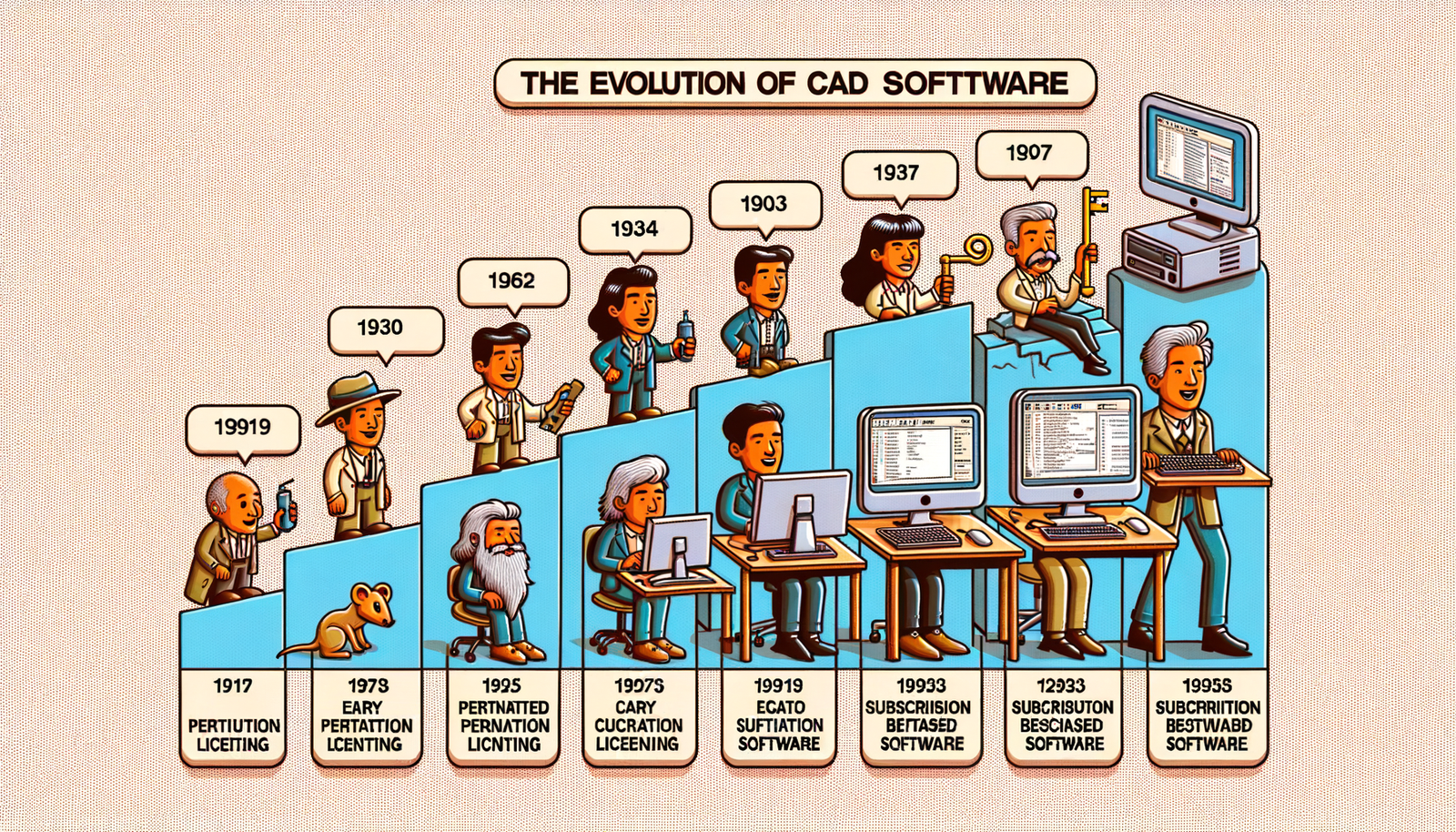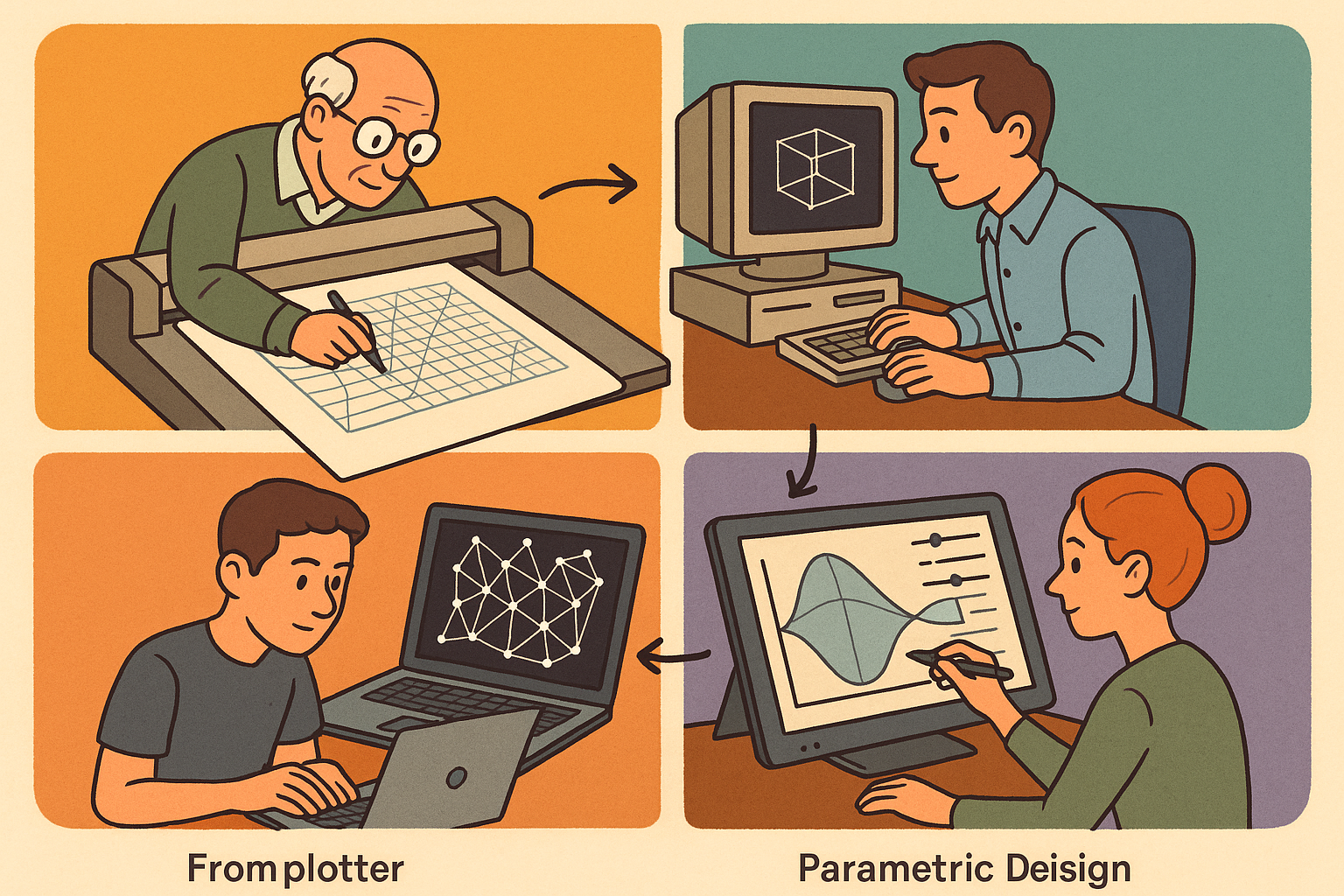Your Cart is Empty
Customer Testimonials
-
"Great customer service. The folks at Novedge were super helpful in navigating a somewhat complicated order including software upgrades and serial numbers in various stages of inactivity. They were friendly and helpful throughout the process.."
Ruben Ruckmark
"Quick & very helpful. We have been using Novedge for years and are very happy with their quick service when we need to make a purchase and excellent support resolving any issues."
Will Woodson
"Scott is the best. He reminds me about subscriptions dates, guides me in the correct direction for updates. He always responds promptly to me. He is literally the reason I continue to work with Novedge and will do so in the future."
Edward Mchugh
"Calvin Lok is “the man”. After my purchase of Sketchup 2021, he called me and provided step-by-step instructions to ease me through difficulties I was having with the setup of my new software."
Mike Borzage
Design Software History: The Evolution of CAD Software: From Perpetual Licensing to Subscription Models
December 01, 2024 10 min read


The landscape of Computer-Aided Design (CAD) software has undergone significant transformations over the decades, but perhaps none as impactful as the shift from perpetual licensing to subscription-based models. This change didn't occur in a vacuum; it was the result of a confluence of economic pressures, technological advancements, and evolving user expectations. The traditional model, which involved substantial upfront costs for perpetual licenses, began to show its limitations in a fast-paced, innovation-driven market. Key industry players like Autodesk, Dassault Systèmes, and emerging competitors recognized the need to adapt to these changing dynamics. They embarked on a journey to reinvent their business models, aiming to offer more flexibility and value to their customers while securing a steadier revenue stream. Understanding this transition requires delving into the factors that propelled it and examining how these companies navigated the complexities of changing long-standing practices.
The Driving Forces Behind the Shift
The move towards subscription models in the CAD software industry was not a spontaneous decision but a strategic response to multiple driving forces. Economic factors played a significant role, as businesses sought ways to reduce upfront expenditures and allocate resources more efficiently. The high initial cost of traditional licenses often posed a barrier to entry for startups and small businesses, limiting their access to essential design tools. Subscription models lowered these barriers by spreading costs over time, making advanced CAD software more accessible.
Technological advancements, especially in cloud computing and Software as a Service (SaaS), made subscription models not only feasible but also attractive. The cloud provided a platform for continuous updates and improvements, ensuring that users always had access to the latest features without the need for manual installations or costly upgrades. This shift also facilitated better customer support and more responsive development cycles, aligning software evolution more closely with user needs.
Changing user expectations cannot be underestimated in this equation. As industries became more collaborative and globally connected, the demand for tools that supported real-time collaboration and version control grew. Users wanted seamless access to their work from any location, integration with other cloud services, and the assurance that they were always using the most current version of the software. **The importance of collaboration tools and up-to-date features** became a significant factor in user satisfaction and productivity, further pushing the industry toward subscription-based services.
Economic Factors
At the heart of the transition lies the contrast between the substantial upfront costs of traditional perpetual licensing and the lower initial investment offered by subscription models. Perpetual licenses often required companies to commit significant capital before realizing any return on investment, which was especially challenging for smaller firms with limited budgets. **Subscription models provided financial flexibility**, allowing businesses to manage cash flow more effectively by converting large capital expenses into manageable operational costs.
This shift also aligned with the broader economic landscape, where businesses increasingly favored scalable solutions that could adjust to their evolving needs. With subscription models, companies could scale their software usage up or down, adding or removing seats as required without being locked into long-term commitments. This adaptability was crucial for startups and small businesses that needed to remain agile in competitive markets.
- Lower initial costs reduced financial barriers to entry.
- Operational expenses replaced large capital expenditures.
- Scalable subscriptions matched business growth and contraction.
Moreover, the predictable cost structure of subscriptions allowed for better budgeting and financial planning. Companies could forecast expenses more accurately, reducing the uncertainty often associated with the need to purchase costly upgrades or additional licenses as the business grew. This financial predictability was attractive not only to small businesses but also to larger organizations seeking to optimize resource allocation.
Technological Advancements
The advent of cloud computing revolutionized how software services were delivered and consumed. The cloud provided the infrastructure necessary for SaaS models, where applications were hosted remotely and accessed over the internet. For the CAD industry, this meant that software could be updated continuously, and new features could be deployed without requiring users to install updates manually. **The role of cloud computing in enabling subscription models** was pivotal, as it allowed companies to offer more dynamic and responsive services.
Software vendors could now monitor usage patterns, gather feedback, and implement improvements more rapidly than ever before. This continuous development cycle benefited users, who received regular enhancements and security updates, ensuring that their tools remained cutting-edge. It also facilitated improved customer support, as issues could be identified and addressed promptly through cloud-based diagnostics and patches.
Additionally, cloud-based services supported greater collaboration among users. Design teams could work on the same models simultaneously from different locations, streamlining workflows and reducing project timelines. **Improvements in software updates and collaborative tools** became a significant selling point for subscription-based CAD solutions, as they aligned with the increasingly distributed and interconnected nature of modern engineering and design work.
Changing User Expectations
The expectations of CAD software users evolved alongside technological advancements. Professionals demanded more than just functional tools; they sought platforms that enhanced productivity, fostered collaboration, and provided seamless integration with other systems. The traditional model of purchasing a static version of software every few years no longer met the needs of users who wanted immediate access to the latest innovations.
**Increased demand for access to the latest software features** drove the push toward subscription models. Users were no longer content with periodic major releases; they expected continuous improvement and immediate access to new capabilities that could give them a competitive edge. Subscription services satisfied this demand by delivering updates in real-time, ensuring that users always worked with the most advanced tools available.
- Desire for real-time collaboration and sharing capabilities.
- Need for seamless integration with other cloud-based tools.
- Expectation of continuous improvement and innovation.
Moreover, the importance of collaboration tools and version control grew as projects became more complex and involved larger, more dispersed teams. Cloud-centric environments facilitated better teamwork, with features that allowed multiple users to work on the same project simultaneously, track changes, and maintain consistent version histories. These capabilities were essential for efficiency and quality control in modern design workflows.
Key Players and Their Strategies
The shift to subscription models was navigated differently by various key players in the CAD software industry, each adopting strategies that reflected their market positions and customer bases. Autodesk, for instance, took a bold approach by fully transitioning its flagship product, AutoCAD, from perpetual licensing to a subscription-only model. This move was part of a broader strategy to embrace cloud technologies and recurring revenue streams.
**Autodesk's transition aimed at user retention and migration**, focusing on demonstrating the added value of subscription services. They offered incentives for existing customers to switch, such as discounted rates and enhanced support. Autodesk also invested heavily in developing new features and cloud-based services to justify the shift, ensuring that users perceived tangible benefits from the change.
In contrast, companies like Dassault Systèmes and PTC employed different tactics. Dassault Systèmes, known for CATIA, and PTC, with its Pro/ENGINEER (now Creo), managed the transition by offering hybrid models that included both perpetual licenses and subscription options. **Their unique offerings in subscription packaging and pricing** allowed users to choose the model that best fit their needs, easing the transition and minimizing disruption.
These companies also differentiated themselves through specialized services and industry-specific solutions. Dassault Systèmes, for example, emphasized its 3DEXPERIENCE platform, integrating design, simulation, and data management in a unified cloud environment. PTC focused on integrating Internet of Things (IoT) technologies and augmented reality into their offerings, appealing to cutting-edge industries and applications.
Autodesk’s Approach
Autodesk's decision to move completely to a subscription model was a landmark moment in the industry. Recognizing the limitations of perpetual licensing in a rapidly evolving technological landscape, Autodesk sought to reinvent its relationship with customers. **The transition from perpetual licensing with AutoCAD** involved significant efforts to communicate the benefits to users, mitigate resistance, and ensure a smooth migration.
One of the key strategies was emphasizing the value-added services that came with subscriptions. Autodesk highlighted access to the latest updates, improved customer support, and enhanced cloud services. They also introduced flexible subscription tiers, allowing users to select plans that matched their usage patterns and budgets. For long-term customers, Autodesk provided loyalty discounts and assistance in transitioning their existing workflows to the new model.
Autodesk's approach also included expanding its product ecosystem to offer more integrated solutions. By leveraging the cloud, they connected various tools like Revit for architecture, Inventor for mechanical design, and Fusion 360 for product development, creating a cohesive environment that encouraged users to stay within the Autodesk family. This strategy not only retained users but also attracted new ones seeking comprehensive design platforms.
Dassault Systèmes and PTC
While Autodesk took an all-in approach, Dassault Systèmes and PTC opted for more gradual transitions, recognizing the diverse needs of their client bases. **Comparing how different companies managed the transition**, Dassault Systèmes maintained perpetual licensing for CATIA while promoting its subscription-based 3DEXPERIENCE platform. This allowed users comfortable with traditional models to continue as before while offering a path to modern, cloud-based solutions.
Dassault's strategy centered around enhancing collaboration and integrating different stages of product development. The 3DEXPERIENCE platform served as a hub for design, simulation, data management, and more, all accessible through a subscription. This approach appealed to larger organizations looking for end-to-end solutions that could be tailored to specific industry needs.
PTC, on the other hand, leveraged its strengths in IoT and augmented reality to differentiate its subscription offerings. By integrating technologies like ThingWorx and Vuforia into its CAD solutions, PTC provided unique value propositions that went beyond traditional design tools. This attracted forward-thinking companies interested in innovating their product development processes.
Both Dassault Systèmes and PTC demonstrated that a one-size-fits-all approach was not necessary. **Their unique offerings in subscription packaging and pricing** allowed them to cater to a broader range of customers, balancing the benefits of new models with the comfort of established practices.
The Rise of Competitors
The shift toward subscription models also opened the door for new competitors to enter the market. Companies like Onshape and Fusion 360 (though Fusion 360 is an Autodesk product, it represented a new approach within the company) adopted subscription-based models from the outset. **Emergence of alternative CAD software that adopted subscription models early on** provided users with fresh options that were often more affordable and innovative.
Onshape, for instance, was one of the first to offer a fully cloud-based CAD platform delivered exclusively through a subscription model. Founded by former SolidWorks executives, Onshape aimed to address the limitations they observed in traditional CAD systems. By offering a platform that required no installations and enabled real-time collaboration, Onshape quickly gained attention, especially among startups and educational institutions.
These new entrants faced challenges, including convincing users to trust cloud-based systems with sensitive design data and competing against well-established brands. However, **the successes and challenges faced by companies like Onshape** highlighted the demand for innovative solutions that leveraged the benefits of subscription models. Their presence also pressured incumbent companies to accelerate their own transitions and adopt similar technologies.
Implications for the Future
The widespread adoption of subscription models in the CAD software industry carries significant implications for both users and providers. On one hand, **the benefits of subscription models** are clear: enhanced access to updates and new features, improved customer support, and the flexibility to scale services according to needs. For software companies, subscription models offer a more predictable revenue stream, enabling better planning and sustained investment in development.
However, there are challenges to consider. **Long-term cost analysis for businesses using subscription models** reveals that while the initial investment is lower, the cumulative cost over time may exceed that of a perpetual license. This raises concerns for users about the total cost of ownership and the potential for vendor lock-in. Companies must weigh the advantages of continuous access and updates against these financial considerations.
Additionally, users who prefer traditional software licensing due to security policies, lack of reliable internet access, or skepticism about cloud services may find their options limited. The industry must address these concerns by offering flexible solutions and ensuring that subscription models can meet the needs of all users.
Benefits of Subscription Models
From a user perspective, subscription models provide several tangible benefits. **Enhanced access to updates, features, and services** ensures that users always have the latest tools at their disposal, which is crucial in industries where innovation drives competitiveness. Regular updates also mean that security vulnerabilities are patched promptly, reducing risk.
The flexibility of subscriptions allows businesses to adjust their usage as needed. They can add or remove licenses in response to project demands without significant financial penalties. This agility supports better resource management and can lead to cost savings in the long run.
For software companies, subscription models translate into steady, predictable revenue streams. This financial stability enables more consistent investment in research and development, leading to better products and services. It also fosters closer relationships with customers, as the ongoing nature of subscriptions requires continuous engagement and support.
Challenges to Consider
Despite the advantages, there are valid concerns associated with the transition to subscription models. The **long-term cost analysis** may reveal higher expenses over time, which is a critical factor for businesses operating with tight margins. Companies must evaluate whether the benefits of continuous updates and support justify the ongoing costs.
There are also considerations regarding data ownership and control. Relying on cloud-based services raises questions about data security, privacy, and compliance with industry regulations. Users need assurances that their sensitive design information is protected and that they retain ownership rights.
Furthermore, some users prefer the stability and control of traditional licensing. They may have established workflows that do not require frequent updates or have infrastructure limitations that make cloud services impractical. The industry must find ways to accommodate these users to avoid alienating segments of their customer base.
Future Trends
Looking ahead, **predictions for how subscription models will evolve** suggest a continued emphasis on flexibility and user-centric services. The integration of artificial intelligence (AI) and machine learning into CAD software is likely to enhance functionality and efficiency, offering personalized experiences based on user behavior and preferences.
The potential impact of AI and cloud technologies extends to automating routine tasks, providing intelligent design suggestions, and improving error detection. These advancements will further justify the value of subscription models, as they rely on continuous learning and updates that are best delivered through cloud-based services.
Moreover, we may see the emergence of more modular subscription offerings, where users can select specific features or tools à la carte. This customization would allow businesses to tailor their subscriptions precisely to their needs, potentially addressing concerns about cost and relevance.
Conclusion
The transition from perpetual licensing to subscription models marks a significant evolution in the CAD software industry. Driven by economic factors, technological advancements, and changing user expectations, this shift reflects a broader trend toward flexibility and continuous improvement. **The significant changes in the CAD software landscape** have reshaped how professionals access and utilize essential design tools.
Balancing user needs for flexibility and access against the financial implications for businesses remains a critical challenge. While subscription models offer numerous benefits, they also require careful consideration of long-term costs and user preferences. The industry's ability to address these concerns will determine how successfully it can navigate this new paradigm.
As subscription models continue to dominate the market, there is immense potential for innovation in design software. Embracing cloud technologies, AI, and collaborative tools will enable providers to deliver more powerful and intuitive solutions. The key will be maintaining a focus on user value, ensuring that the evolution of business models translates into tangible benefits for those who rely on these tools to shape the world around us.
Also in Design News

Design Software History: From Plotters to Procedural Intent: A Technical History of Generative and Parametric Design Software
January 04, 2026 13 min read
Read More
Semantic Meshes: Enabling Analytics-Ready Geometry for Digital Twins
January 04, 2026 12 min read
Read MoreSubscribe
Sign up to get the latest on sales, new releases and more …



